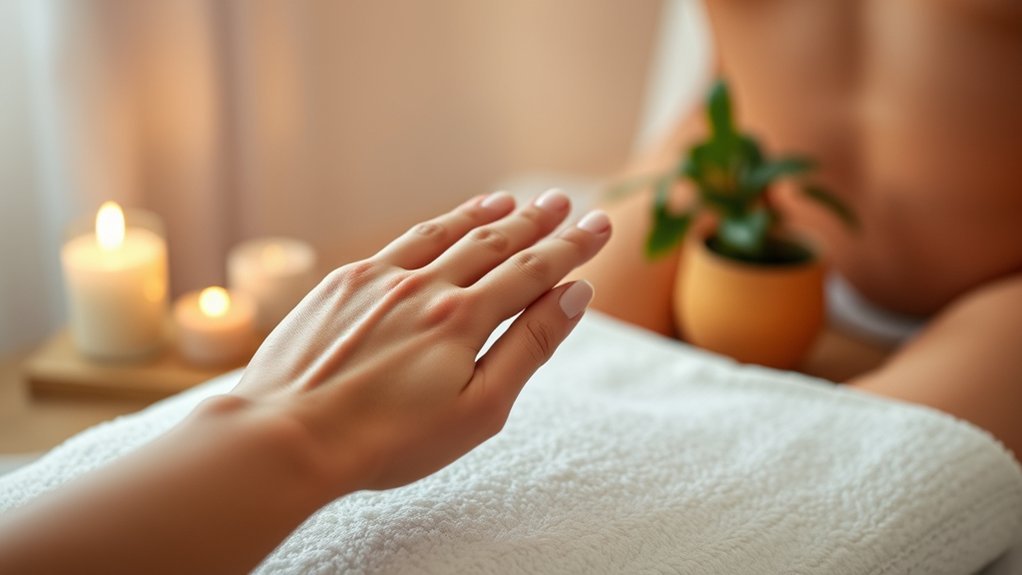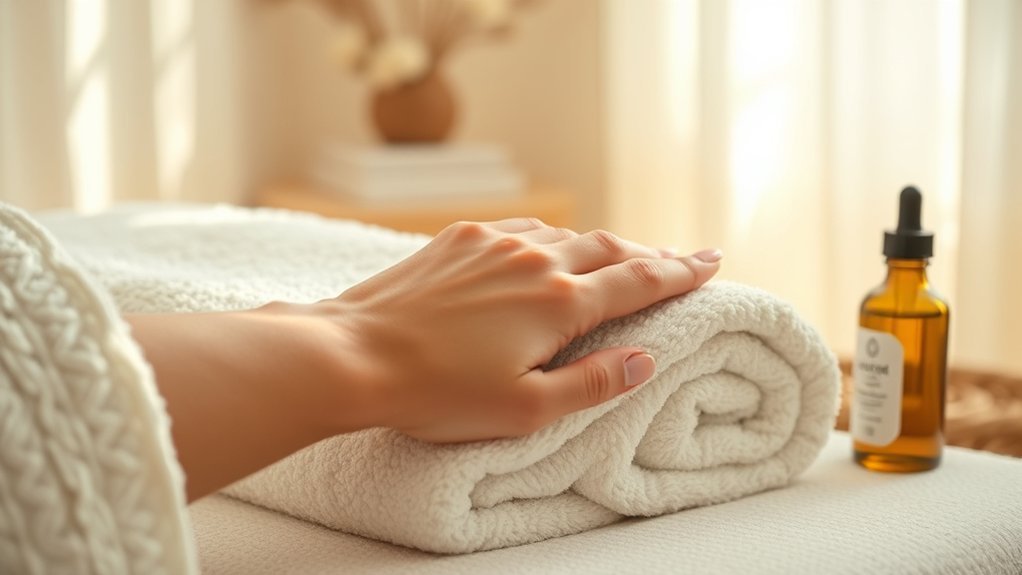Steering perineal massage during pregnancy can feel overwhelming, but it doesn’t have to be. It’s important to know the do’s and don’ts to create a comfortable and positive experience. By understanding when to start and how to prepare, you can embrace this practice with confidence. As you explore the techniques, you’ll find that communication and mindfulness play key roles. Let’s uncover the essential steps to guarantee you approach this practice safely and effectively.
Understanding Perineal Massage

Understanding perineal massage can be an empowering tool for expectant parents, especially as you prepare for childbirth.
This gentle technique involves massaging the perineum—the area between your vaginal opening and anus—to help increase elasticity and reduce the risk of tearing during delivery.
It’s a simple practice that you or your partner can do together, fostering intimacy and connection.
As you engage in this process, it’s essential to create a calm environment and approach it with patience.
You might find it helpful to use a lubricant, such as oil, to enhance comfort.
Remember, every body is different, so listening to your instincts and feelings throughout the practice is vital.
Embrace this journey—you’re taking an important step toward a positive birth experience!
When to Start Practicing

Knowing when to start practicing perineal massage can make a significant difference in your preparation for childbirth.
Ideally, you should begin around 34 weeks into your pregnancy. This gives you enough time to get comfortable with the technique and incorporate it into your routine.
Start by practicing once or twice a week to allow your body to adapt. Remember, it’s important to listen to your body and stop if you feel any discomfort.
Practice perineal massage once or twice a week, listening to your body and stopping if you feel any discomfort.
You’ll want to approach this practice with patience and care, so don’t rush the process.
As you prepare for labor, perineal massage can help improve elasticity and reduce the risk of tearing, making your experience more positive.
Trust yourself—you’re doing great!
Preparing for Perineal Massage

Before you start your perineal massage, it’s important to gather everything you’ll need, like oil and clean towels.
Finding a comfortable position can help you relax and make the process easier.
Setting the mood with soft lighting and music can also create a calming atmosphere, making this experience more enjoyable for you.
Gather Necessary Supplies
Gathering the right supplies is essential for an effective perineal massage experience. Start by acquiring a high-quality lubricant, as this will help minimize friction and enhance comfort.
Look for options that are safe and suitable for your skin, such as natural oils or water-based lubricants. You’ll also want to have clean towels nearby for easy cleanup and to provide a comfortable surface.
A mirror can be helpful if you’re looking to gain better visibility and control during the massage. Finally, consider a calming environment—soft lighting, soothing music, or even a favorite scent can help you feel more at ease.
With these supplies ready, you’ll be well-prepared to commence your perineal massage journey.
Choose a Comfortable Position
Finding a comfortable position is essential for an effective perineal massage. You want to feel relaxed and at ease, so take a moment to explore your options.
Many find that lying on their side with knees bent offers a sense of security and allows for easy access. Alternatively, sitting on the edge of a bed or chair can work well too.
Just make sure you support your body comfortably, perhaps with cushions or pillows. Remember, this is about your comfort and relaxation, so don’t hesitate to adjust until you find what feels right for you.
A stable, comfortable position will help you focus on the massage and make the experience more enjoyable.
Set the Mood
Creating a calming environment can greatly enhance your perineal massage experience. Begin by finding a quiet space where you won’t be interrupted. Soft lighting and soothing scents can help you relax. Consider playing gentle music or nature sounds to create a peaceful atmosphere.
Here’s a quick guide to set the mood:
| Element | Suggestions |
|---|---|
| Lighting | Dim lights, candles |
| Scents | Lavender, chamomile essential oils |
| Music | Soft instrumental, nature sounds |
| Comfort Items | Soft blankets, pillows |
Proper Techniques for Perineal Massage
When it comes to perineal massage, mastering the right techniques is essential for both comfort and effectiveness.
Start by ensuring your hands are clean and using a water-based lubricant to reduce friction. You can sit or lie in a comfortable position, allowing your body to relax.
Ensure your hands are clean and use a water-based lubricant while finding a comfortable position to relax your body.
Gently insert one or two fingers into the vagina, pressing down toward the rectum. Use a slow, firm motion, applying pressure on the perineum for about 1-2 minutes. Breathe deeply, and listen to your body—if you feel discomfort, ease off.
It’s important to communicate with your partner if you’re doing this together. Practicing these techniques regularly can help build confidence and promote relaxation, making the experience much more enjoyable.
Common Mistakes to Avoid
While it might seem straightforward, there are several common mistakes people make during perineal massage that can hinder both comfort and effectiveness.
One key issue isn’t using enough lubricant, which can lead to discomfort. Always choose a suitable, gentle lubricant to ease the process.
Another mistake is applying too much pressure; it’s important to listen to your body and work within your comfort zone.
Rushing through the massage can also be counterproductive—take your time to relax and focus on the sensations.
Finally, neglecting to maintain clean hands can introduce bacteria, so always wash your hands before starting.
Frequency and Duration of Massage
To guarantee the best results from perineal massage, it’s essential to establish a consistent routine that suits your needs. Aim for about 5 to 10 minutes of massage, ideally starting around 34 weeks into your pregnancy. You can perform this massage 2 to 3 times a week, gradually increasing frequency as you get more comfortable.
Here’s a simple schedule you might find helpful:
| Day | Activity |
|---|---|
| Monday | Massage |
| Wednesday | Massage |
| Friday | Massage |
| Sunday | Rest or Light Stretch |
Signs of Discomfort or Pain
It’s important to recognize any signs of discomfort or pain during perineal massage, as your body will communicate what feels right and what doesn’t.
Open communication with your partner or support person can help you adjust techniques to guarantee a more comfortable experience.
Recognizing Pain Signals
Recognizing pain signals during perineal massage is essential for your comfort and well-being. Pay attention to your body’s responses; if you feel sharp pain, burning, or intense discomfort, it’s vital to stop immediately.
These sensations can indicate that you’re applying too much pressure or that the technique isn’t suitable for you. Remember, gentle stretching should feel relieving, not painful.
You might also experience discomfort if you’re tense or anxious, so take a moment to breathe and relax. It’s okay to adjust your position or technique if something doesn’t feel right.
Trust your instincts; your body knows what it needs. Prioritize your comfort, and don’t hesitate to pause or modify your approach as needed.
Importance of Communication
Effective communication is essential during perineal massage, especially when it comes to expressing any signs of discomfort or pain. Being open about how you feel helps guarantee a positive experience. If something doesn’t feel right, don’t hesitate to speak up. This will not only reassure you but also guide the person assisting you in providing the best care possible.
| Signs of Discomfort | What to Communicate | Suggested Response |
|---|---|---|
| Sharp pain | “I’m feeling sharp pain.” | Stop and reassess technique. |
| Aching sensation | “I feel an ache.” | Adjust pressure or position. |
| Numbness | “My skin feels numb.” | Pause and check comfort level. |
| General discomfort | “I’m uncomfortable.” | Discuss feelings to find a solution. |
Your comfort is the priority!
Adjusting Techniques Accordingly
When you experience discomfort during perineal massage, it’s essential to adjust techniques right away to guarantee your comfort and safety. Pay attention to your body’s signals; if you feel pain, pause and reassess.
You might need to change the pressure, angle, or even the duration of the massage. Try using lighter pressure or different hand positions to find what feels best for you.
Communicate openly with your partner or caregiver about what feels right and what doesn’t. If discomfort persists, it’s okay to stop altogether.
Your well-being is paramount, and perineal massage should be a positive experience. Remember, there’s no rush—take your time and make sure you feel relaxed and at ease throughout the process.
Benefits of Perineal Massage
Perineal massage offers numerous benefits that can enhance your birthing experience, especially if you’re approaching labor. By practicing this technique, you can increase flexibility in the perineum, which may reduce the risk of tearing during delivery.
It also promotes relaxation, helping you feel more in control and less anxious as you prepare for childbirth. This gentle practice can improve blood circulation, supporting healing post-delivery.
Additionally, it encourages awareness of your body, fostering a deeper connection with your pregnancy. You might even find it brings comfort and relief from pressure during labor.
Consulting With Healthcare Professionals
As you explore the benefits of perineal massage, it’s essential to consult with healthcare professionals to guarantee you’re approaching it safely and effectively. They can provide guidance tailored to your specific circumstances, ensuring you understand the technique and its potential impact on your body.
| Professionals | What They Can Offer |
|---|---|
| Obstetricians | Expert advice on prenatal care |
| Midwives | Personalized support during pregnancy |
| Physical Therapists | Techniques to strengthen pelvic floor |
| Lactation Consultants | Guidance on postpartum recovery |
Frequently Asked Questions
Can Perineal Massage Be Done During Pregnancy?
Yes, you can do perineal massage during pregnancy. It may help prepare your body for childbirth and reduce tearing. Just remember to approach it gently and consult your healthcare provider for personalized advice.
What Tools or Oils Are Recommended for Perineal Massage?
For perineal massage, you can use natural oils like almond or coconut oil. These oils help reduce friction and enhance comfort. Remember to choose a tool or your fingers that feels comfortable for you.
Is Perineal Massage Safe for All Birthing Methods?
Perineal massage is generally safe for most birthing methods, but it’s best to consult your healthcare provider. They can guide you based on your specific situation and help you feel confident and informed.
How Can Partners Assist With Perineal Massage?
Your partner can assist by creating a calm environment, helping with relaxation, and gently guiding your hands during the massage. Communication’s key—discussing comfort levels and preferences will enhance the experience for both of you.
Are There Cultural Practices Related to Perineal Massage?
Cultural practices around perineal massage are like a rich tapestry, woven with diverse traditions. In many communities, it’s embraced for its benefits, fostering connection and easing birthing experiences, reflecting deep respect for the body’s journey.
Conclusion
Incorporating perineal massage into your routine can feel like opening a treasure chest of comfort and confidence for your birthing experience. By following the do’s and don’ts, you’ll not only prepare your body but also bond with your partner in this intimate journey. Remember, it’s all about listening to your body and taking things at your own pace. Embrace this practice, and you might just find yourself feeling like a superhero on the path to motherhood!
